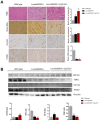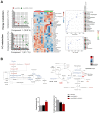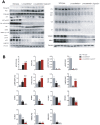Systemic overexpression of C-C motif chemokine ligand 2 promotes metabolic dysregulation and premature death in mice with accelerated aging
- PMID: 33104522
- PMCID: PMC7655213
- DOI: 10.18632/aging.104154
Systemic overexpression of C-C motif chemokine ligand 2 promotes metabolic dysregulation and premature death in mice with accelerated aging
Abstract
Injection of tissues with senescent cells induces changes that mimic aging, and this process is delayed in mice engineered to eliminate senescent cells, which secrete proinflammatory cytokines, including C-C motif chemokine ligand 2 (Ccl2). Circulating levels of Ccl2 correlate with age, but the impact of Ccl2 on tissue homeostasis has not been established. We generated an experimental model by crossbreeding mice overexpressing Ccl2 with progeroid mice bearing a mutation in the lamin A (Lmna) gene. Wild-type animals and progeroid mice that do not overexpress Ccl2 were used as controls. Ccl2 overexpression decreased the lifespan of the progeroid mice and induced the dysregulation of glycolysis, the citric acid cycle and one-carbon metabolism in skeletal muscle, driving dynamic changes in energy metabolism and DNA methylation. This impact on cellular bioenergetics was associated with mitochondrial alterations and affected cellular metabolism, autophagy and protein synthesis through AMPK/mTOR pathways. The data revealed the ability of Ccl2 to promote death in mice with accelerated aging, which supports its putative use as a biomarker of an increased senescent cell burden and for the assessment of the efficacy of interventions aimed at extending healthy aging.
Keywords: C-C motif chemokine ligand 2; energy metabolism; one-carbon metabolism; progeria.
Conflict of interest statement
Figures




Similar articles
-
Chemokine C-C motif ligand 2 overexpression drives tissue-specific metabolic responses in the liver and muscle of mice.Sci Rep. 2020 Jul 20;10(1):11954. doi: 10.1038/s41598-020-68769-7. Sci Rep. 2020. PMID: 32686726 Free PMC article.
-
Cellular stress and AMPK activation as a common mechanism of action linking the effects of metformin and diverse compounds that alleviate accelerated aging defects in Hutchinson-Gilford progeria syndrome.Med Hypotheses. 2018 Sep;118:151-162. doi: 10.1016/j.mehy.2018.06.029. Epub 2018 Jun 28. Med Hypotheses. 2018. PMID: 30037605
-
Vascular Smooth Muscle-Specific Progerin Expression Accelerates Atherosclerosis and Death in a Mouse Model of Hutchinson-Gilford Progeria Syndrome.Circulation. 2018 Jul 17;138(3):266-282. doi: 10.1161/CIRCULATIONAHA.117.030856. Epub 2018 Feb 28. Circulation. 2018. PMID: 29490993 Free PMC article.
-
Nuclear matrix, nuclear envelope and premature aging syndromes in a translational research perspective.Semin Cell Dev Biol. 2014 May;29:125-47. doi: 10.1016/j.semcdb.2014.03.021. Epub 2014 Mar 22. Semin Cell Dev Biol. 2014. PMID: 24662892 Review.
-
Cell autonomous and systemic factors in progeria development.Biochem Soc Trans. 2011 Dec;39(6):1710-4. doi: 10.1042/BST20110677. Biochem Soc Trans. 2011. PMID: 22103512 Review.
Cited by
-
Progeria and Aging-Omics Based Comparative Analysis.Biomedicines. 2022 Sep 29;10(10):2440. doi: 10.3390/biomedicines10102440. Biomedicines. 2022. PMID: 36289702 Free PMC article.
-
Loss of RNA binding protein HuD facilitates the production of the senescence-associated secretory phenotype.Cell Death Dis. 2022 Apr 11;13(4):329. doi: 10.1038/s41419-022-04792-y. Cell Death Dis. 2022. PMID: 35411051 Free PMC article.
-
Intestinal Permeability, Gut Inflammation, and Gut Immune System Response Are Linked to Aging-Related Changes in Gut Microbiota Composition: A Study in Female Mice.J Gerontol A Biol Sci Med Sci. 2024 Apr 1;79(4):glae045. doi: 10.1093/gerona/glae045. J Gerontol A Biol Sci Med Sci. 2024. PMID: 38364863 Free PMC article.
-
On the Role of Paraoxonase-1 and Chemokine Ligand 2 (C-C motif) in Metabolic Alterations Linked to Inflammation and Disease. A 2021 Update.Biomolecules. 2021 Jul 1;11(7):971. doi: 10.3390/biom11070971. Biomolecules. 2021. PMID: 34356595 Free PMC article. Review.
References
Publication types
MeSH terms
Substances
LinkOut - more resources
Full Text Sources
Miscellaneous

